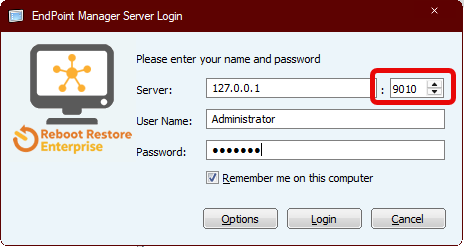Endpoint Manager - changing the server port number
applies to Reboot Restore Enterprise/Standard/Pro & RollBack Rx Pro/Server
This guide provides step-by-step instructions for changing the default TCP port used by the EndPoint Manager Server for client communication.
The default port, TCP 9000, may sometimes be unavailable because it is in use by another application. We will use TCP 9010 as the replacement port in this example.
Phase 1: Configure the EndPoint Manager Server
Follow these steps on the server machine to update the port setting:
Step 1: Stop the Service
- Open the Windows Services manager (Start > Run > type in services.msc)
- Locate the RmServer. This is the EndPoint Manager Server Service. .
- Right-click the service and select Stop
Step 2: Edit the Configuration File
- Navigate to the EndPoint Manager installation folder (i.e. C:\Program Files\Reboot Restore Enterprise\Reboot Restore EndPoint Manager
- Open the file named settings.ini using
- Add the following two lines
[RmServer]
Port=9010
- save the changes and close your Notepad
Step 3: Restart the Service
- Open the Windows Services manager (Start > Run > type in services.msc)
- Locate the RmServer. This is the EndPoint Manager Server Service. .
- Right-click the service and select Start
The server is now configured to listen for connections on the new port (e.g., 9010).
Phase 2: Update the Console and Client Settings
You must change the port settings to match the new server port (e.g., 9010) in the following locations:
-
EndPoint Manager Console: Update the port number on the console's logon screen

-
Client Workstations: Update the port number in the Network Connection screen settings on all client machines.

Please submit a support ticket if you need further assistance